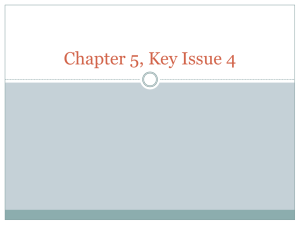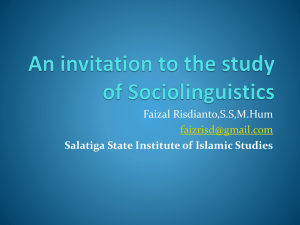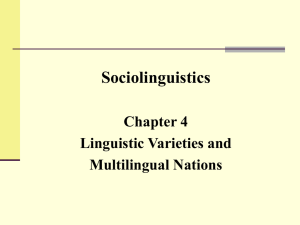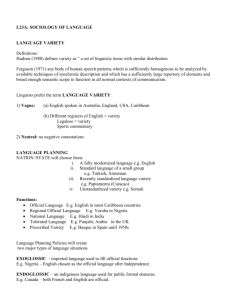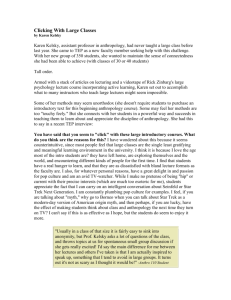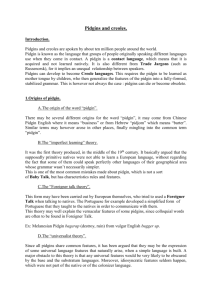Language diversity in the global era
advertisement
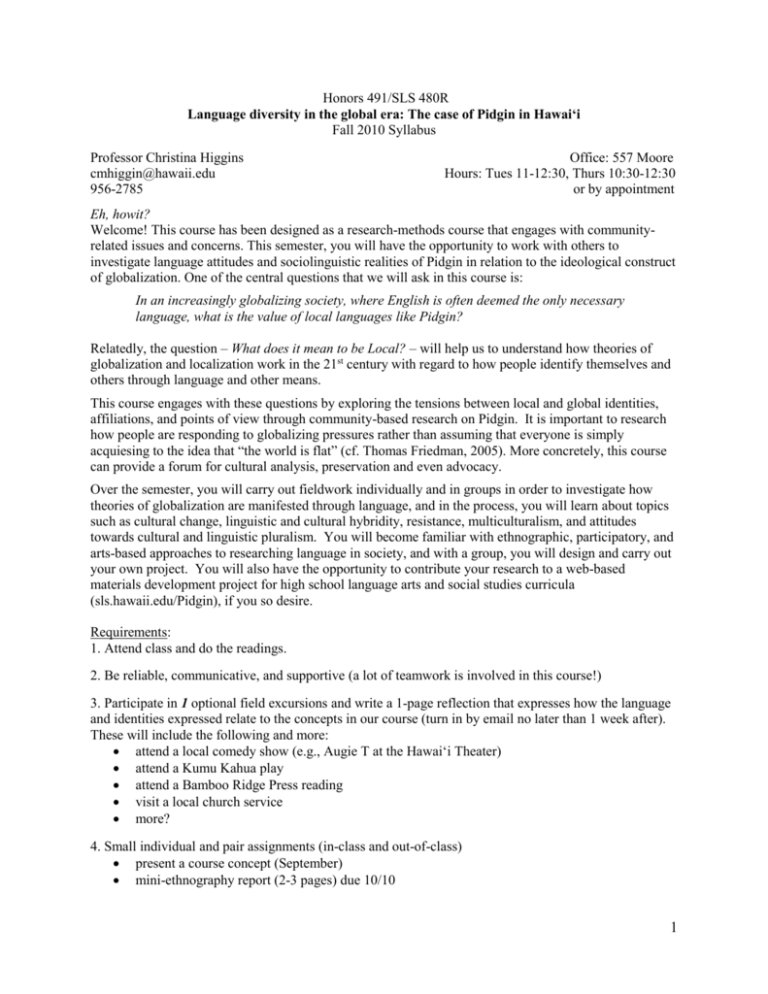
Honors 491/SLS 480R Language diversity in the global era: The case of Pidgin in Hawai‘i Fall 2010 Syllabus Professor Christina Higgins cmhiggin@hawaii.edu 956-2785 Office: 557 Moore Hours: Tues 11-12:30, Thurs 10:30-12:30 or by appointment Eh, howit? Welcome! This course has been designed as a research-methods course that engages with communityrelated issues and concerns. This semester, you will have the opportunity to work with others to investigate language attitudes and sociolinguistic realities of Pidgin in relation to the ideological construct of globalization. One of the central questions that we will ask in this course is: In an increasingly globalizing society, where English is often deemed the only necessary language, what is the value of local languages like Pidgin? Relatedly, the question – What does it mean to be Local? – will help us to understand how theories of globalization and localization work in the 21st century with regard to how people identify themselves and others through language and other means. This course engages with these questions by exploring the tensions between local and global identities, affiliations, and points of view through community-based research on Pidgin. It is important to research how people are responding to globalizing pressures rather than assuming that everyone is simply acquiesing to the idea that “the world is flat” (cf. Thomas Friedman, 2005). More concretely, this course can provide a forum for cultural analysis, preservation and even advocacy. Over the semester, you will carry out fieldwork individually and in groups in order to investigate how theories of globalization are manifested through language, and in the process, you will learn about topics such as cultural change, linguistic and cultural hybridity, resistance, multiculturalism, and attitudes towards cultural and linguistic pluralism. You will become familiar with ethnographic, participatory, and arts-based approaches to researching language in society, and with a group, you will design and carry out your own project. You will also have the opportunity to contribute your research to a web-based materials development project for high school language arts and social studies curricula (sls.hawaii.edu/Pidgin), if you so desire. Requirements: 1. Attend class and do the readings. 2. Be reliable, communicative, and supportive (a lot of teamwork is involved in this course!) 3. Participate in 1 optional field excursions and write a 1-page reflection that expresses how the language and identities expressed relate to the concepts in our course (turn in by email no later than 1 week after). These will include the following and more: attend a local comedy show (e.g., Augie T at the Hawai‘i Theater) attend a Kumu Kahua play attend a Bamboo Ridge Press reading visit a local church service more? 4. Small individual and pair assignments (in-class and out-of-class) present a course concept (September) mini-ethnography report (2-3 pages) due 10/10 1 mini-linguistic landscape analysis (2-3-pages) due 10/17 5. Work with your group to produce a final research project and group presentation. Make sure that each group member has a different ‘angle’ on the project with specific responsibilities that can be articulated in your final report. 6. Turn in a report (12-15 pages) that represents the work that you have done (also can be turned in as a website or other media format, if you wish; consult with the instructor). This report should also engage with the question of what theories of globalization you have found to be helpful in explaining the position of Pidgin in Hawai‘i in your community-based inquiry. Grading: Attendance, participation 1 optional field excursion & reflection Small assignments Final project 15% -team proposal presentation 20% -sketch 20%-final presentation 45%- final report/website 15% 15% 20% 50% (2% reduced for each class absence) Doing Research in the Honors Program The Honors Program promotes critical thinking and oral, written and audio-visual communication skills, respect for diversity and commitment to social justice, civic participation and capacity for leadership. It also promotes project-based experiential learning involving community-based research or creative work. For these reasons, we will make this course as “student-centered” as possible – which means that the research questions and approaches will ultimately be up to you to decide. Please think of me more as your facilitator and as an additional ‘head’ for brainstorming ideas and possibilities. Student Learning Outcomes To develop a deeper understanding of globalization-localization theories and realities To understand and practice community-based research (ethnography, participatory approaches, artsbased research) To develop a deeper understanding of the sociolinguistics of Pidgin vis-à-vis other languages in Hawai‘i To practice the art of working as a team to research a topic and to articulate what is ‘found’ Topics, readings, assignments, and due dates 8/24 Introduction to the course Introductions; Drawing globalization; Pidgin realia – what does it mean? 8/26 Theories of globalization Pieterse, J. 2009. Globalization and culture: Three paradigms. Chapter 3 in Globalization and culture: Global melange. (2nd ed.) Lanham, MD: Rowen & Littlefield. Appadurai, A. [1990] 2008. Disjuncture and difference in the global cultural economy. In F. Lechner & J. Boli (eds) The globalization reader (pp. 95-104). Malden, MA: Blackwell. 8/31 Language attitudes in the USA (guest instructor Toshi Furukawa) 2 Lippi-Green, R. 1997. Chapter 1 (pp. 7-40) and Chapter 9 (pp. 176-201) in English with an accent. New York: Routledge. American Tongues. 1984. (to be viewed in class) 9/2 Attitudes about Pidgin and Pidgin rights (guest instructor Toshi Furukawa) Tamura, E. 1996. Power, status, and Hawai'i Creole English: An example of linguistic intolerance in American history. Pacific Historical Review 431-454. Tonouchi, L. 2004. Da state of Pidgin address. College English 67, 1, 75-82. Pidgin: The Voice of Hawai‘i. 2009. (to be viewed in class) 9/7 Pidgin linguistics – a 1-day crash course 9/9 Pidgin language awareness activities (from www.sls.hawaii.edu/Pidgin) 9/14 Getting to know more about research on Pidgin (educational contexts) Da Pidgin Coup. 1999. Pidgin and Education. (online): www.hawaii.edu/sls/pidgin.html Eades, D. et al. 2006. Pidgin, local identity and schooling in Hawai‘i. In S. Nero (ed.) Dialects, Englishes, Creoles, and education (pp. 139-166). Mahwah NJ: Erlbaum. 9/16 Getting to know more about research on Pidgin Marlow, M. & Giles, H. 2008. Who you tink you, talkin propah? Hawaiian Pidgin demarginalised. Journal of Multicultural Discourses 3, 53-68. Furukawa, T. 2007. “No flips in the pool”: Discursive practice in Hawai‘i Creole. Pragmatics 17, 371-385. 9/21 Globalization concepts and local language/culture practices For these two days, you will be responsible for sharing the task of presenting a concept (in bold) to the class with your pair/group (for about 15 minutes), and for conveying examples from your assigned reading that help to illustrate the concept. You will also be expected to suggest some ways in which Hawai‘i’s local linguistic landscape –and Pidgin in particular -- may provide interesting illustrations of the idea. You can also provide examples from other contexts. Commodification: ____________&____________ Localism: ____________&____________ Johnstone, B. 2009. Pittsburghese shirts: Commodification and the enregisterment of an urban dialect. American Speech 84, 157-175. Hybridity: ____________&____________ Glocalization: ____________&____________ Watson, J. 2009. McDonald’s in Hong Kong. In F. Lechner & J. Boli (eds.) The globalization reader (pp. 126-134). Malden MA: Blackwell. 9/23 Homogenization: ____________&____________ Cultural Imperialism: ____________&____________ Goh, I., & Tan, Y. 2007. Singapore Pharmakon. Social Identities 13, 393-409. 3 Deterritorialization: ____________&____________ Cultural Globalization: ____________&____________ Pennycook, A. 2003. Global Englishes, Rip Slyme, and performativity. Journal of Sociolinguistics 7/4, 513-533 9/24 optional FIELDTRIP #1: Augie T at the Hawai‘i Theater (8 pm) purchase own ticket RESEARCH METHODS 9/28 Arts-based research Barndt, D. 2004. By whom and for whom? Intersections of participatory research and community art. In A. Cole et al. (eds) Provoked by art: Theorizing arts-informed research (pp. 221-234). Halifax: Backalong Books. Goldstein, T. 2004. Performed ethnography for critical language teacher education. In B. Norton & K. Toohey (eds) Critical pedagogies and language learning (pp. 311326). Cambridge UP. 9/30 Arts-based research Higgins C. et al. (in review). Beyond contrastive analysis and codeswitching: Student videoethnography as a challenge to linguicism in Hawai‘i. Linguistics and Education. Ha Kam Wi Tawk Pidgin Yet? (to be viewed in class) 10/5 Ethnographic fieldwork Emerson, R. , Fretz, R. & Shaw, L. 1995. Writing ethnographic fieldnotes. Chapters 1-2. University of Chicago Press. 10/7 Emerson, R. , Fretz, R. & Shaw, L. 1995. Writing ethnographic fieldnotes. Chapter 3. University of Chicago Press. Mini-fieldwork experience – meet at City Mill (St. Louis Heights) at 1:30 Homework: Turn in a 2-3 page write up of your field notes experience. Reflect on the methodological procedures and any difficulties you experienced. Also reflect on ‘what you learned’ about language, identity, and any globalization/localization concepts we’ve discussed in class. Turn in your reflection by email - due 10/10. 10/12 Linguistic landscapes Leeman, J. & Modan, G. 2009. Commodified language in Chinatown: A contextualized approach to linguistic landscape. Journal of Sociolinguistics, 13, 332–362. 10/14 Linguistic landscape field trip: Kapahulu Avenue (meet at Rainbow Drive Inn at 1:30 pm) Homework: Turn in a 2-3 page write up of your experience, including images of linguistic signs or fieldnotes about conversational usage. Reflect on the methodological procedures and any difficulties you experienced. Also reflect on ‘what you learned’ about about language, identity, and any globalization/localization concepts we’ve discussed in class. Due 10/17 by email. 10/19 Interviewing Kvale, S. & Brinkman, S. 2009. Chs. 7 and 10 in InterViews: Learning the craft of 4 qualitative research interviewing. London: Sage. Quinn, N. 2005. How to reconstruct schemas people share, from what they say. In Finding Culture in Talk, (pp. 35-81). London: Palgrave. 10/21 Interviewing practice in class TEAM-BASED PROJECT PLANNING AND RESEARCH 10/26 Sorting out of topics and interests among the class into project teams 10/28 Proposals due from teams – 10 minute oral presentations in class with feedback from all 10/28 through 11/27: optional FIELDTRIP #2: The Great Kauai Train Robbery at Kumu Kahua Theater (note that Thursdays are reduced price for students - 8 pm, purchase own ticket) 11/2 HOLIDAY-Election day 11/4 TBA 11/9 Team meetings- develop 4-5 page sketch for entire project (due 11/14 by email) 11/11 HOLIDAY-Veteran’s Day 11/16 Instructor meetings with teams 11/18 TBA 11/23 Team meetings to plan presentations 11/25 HOLIDAY -Thanksgiving 12/2 Team meetings to plan presentations and final reports; CAFÉ evaluations 12/7 Final project presentations 12/9 Final project presentations Final project reports/websites due 12/12 Project directions (just to help get you started brainstorming): 1. An ethnographic play (write it, perform it; work with others to write/perform it, e.g. HS students) 2. A slam poetry festival about Pidgin, in Pidgin (facilitate it, perform it) 3. A film (produce it, disseminate it) 4. Ethnographic observations/fieldnotes (and possibly interviews) with high school students working on a claymation project about Pidgin (with Christina as PI) 5. Interviews with Kumu Kahua staff and audiences regarding Local theater 6. Interviews across at least two generations of a family regarding language loss/maintenance and the charting of a family ‘linguistic tree’. 5 7. Interviews with founders of Bamboo Ridge Press, authors, and/or audience goers 8. Linguistic landscape of Waikiki tourist shops, Chinatown, Puck’s Alley 9. Ethnographic observations/fieldnotes of a workplace, classroom or school 10. Ethnographic observations of Local comedy and interviews with audience members Resources: Please note that the Charlene J. Sato Center for Pidgin, Creole and Dialect Studies houses the most comprehensive collection of articles, books, and other documents about Pidgin in Hawai‘i. Kent Sakoda, the Center Director, has a tremendous amount of knowledge stored in his office and in his head (sakoda@hawaii.edu). The Center is located at TP 101, behind the Korean Studies building. A short list of relevant books: Blommaert, J. 2010. The sociolinguistics of globalization. Cambridge UP. Migge, B., Leglise, I., & Bartens, A. (eds.) 2010. Creoles in education: An appraisal of current programs and projects. Amsterdam: Benjamins. Sakoda, K. & Siegel, J. 2003. Pidgin grammar: An introduction to the creole language of Hawai‘i. Honolulu: Bess Press. Shohamy, E. & Gorter, D. (eds). 2010. Linguistic landscape: Expanding the scenery. New York and London: Routledge. Tan, P. & Rubdy, R. (eds.) 2008. Language as commodity: Global structures, local marketplaces. London: Continuum. Tonouchi, L. 2002, 2009. Living Pidgin: Contemplations on Pidgin culture. Kaneohe: Tinfish Press. Tonouchi, L. 2001. Da Word. Honolulu: Bamboo Ridge. If you feel that you need reasonable accommodations because of the impact of a disability, please speak with me privately to discuss your needs, and/or contact the KOKUA Program (956-7511 or kokua@hawaii.edu). We will be very happy to work with you and/or the KOKUA Program. 6
